Evidence that G(z)-proteins couple to hypothalamic 5-HT(1A) receptors in vivo
- PMID: 10777773
- PMCID: PMC6773124
- DOI: 10.1523/JNEUROSCI.20-09-03095.2000
Evidence that G(z)-proteins couple to hypothalamic 5-HT(1A) receptors in vivo
Abstract
Using in situ hybridization and immunoblot analysis, the present studies identified G(z) mRNA and G(z)-protein in the hypothalamic paraventricular nucleus. The role of G(z)-proteins in hypothalamic 5-HT(1A) receptor signaling was examined in vivo. Activation of 5-HT(1A) receptors increases the secretion of oxytocin and ACTH, but not prolactin. Intracerebroventricular infusion (3-4 d) of G(z) antisense oligodeoxynucleotides, with different sequences and different phosphorothioate modification patterns, reduced the levels of G(z)-protein in the hypothalamic paraventricular nucleus, whereas missense oligodeoxynucleotides had no effect. Neither antisense nor missense oligodeoxynucleotide treatment altered basal plasma levels of ACTH, oxytocin, or prolactin, when compared with untreated controls. An antisense-induced decrease in hypothalamic G(z)-protein levels was paralleled by a significant decrease in the oxytocin and ACTH responses to the 5-HT(1A) agonist 8-hydroxy-dipropylamino-tetralin (8-OH-DPAT). In contrast, the prolactin response to 8-OH-DPAT (which cannot be blocked by 5-HT(1A) antagonists) was not inhibited by G(z) antisense oligodeoxynucleotides. G(z)-proteins are the only members of the G(i)/G(o)-protein family that are not inactivated by pertussis toxin. In a control experiment, pertussis toxin treatment (1 microgram/5 microliter, i.c.v.; 48 hr before the 8-OH-DPAT challenge) did not inhibit the ACTH response, potentiated the oxytocin response, and eliminated the prolactin response to 8-OH-DPAT. Thus, pertussis toxin-sensitive G(i)/G(o)-proteins do not mediate the 5-HT(1A) receptor-mediated increase in ACTH and oxytocin secretion. Combined, these studies provide the first in vivo evidence for a key role of G(z)-proteins in coupling hypothalamic 5-HT(1A) receptors to effector mechanisms.
Figures


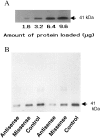
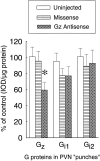
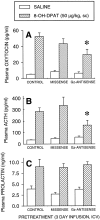
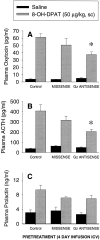
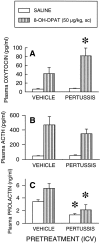
References
-
- Albert PR, Lembo P, Storring JM, Charest A, Saucier C. The 5HT1A receptor: signaling, desensitization, and gene transcription. Neuropsychopharmacology. 1996;14:19–25. - PubMed
-
- Aulakh CS, Wozniak KM, Haas M, Hill JL, Zohar J, Murphy DL. Food intake, neuroendocrine and temperature effects of 8-OHDPAT in the rat. Eur J Pharmacol. 1988;146:253–259. - PubMed
-
- Bagdy G. Role of the hypothalamic paraventricular nucleus in 5-HT1A, 5-HT2A and 5-HT2C receptor-mediated oxytocin, prolactin and ACTH/corticosterone responses. Behav Brain Res. 1996;73:277–280. - PubMed
-
- Bagdy G. The role of biogenic amines in neuroendocrine regulation in conscious rats. In: Van de Kar LD, editor. Methods in neuroendocrinology. CRC; Boca Raton: 1998. pp. 145–161.
-
- Barr AJ, Brass LF, Manning DR. Reconstitution of receptors and GTP-binding regulatory proteins (G proteins) in Sf9 cells. A direct evaluation of selectivity in receptor G protein coupling. J Biol Chem. 1997;272:2223–2229. - PubMed
Publication types
MeSH terms
Substances
Grants and funding
LinkOut - more resources
Full Text Sources
